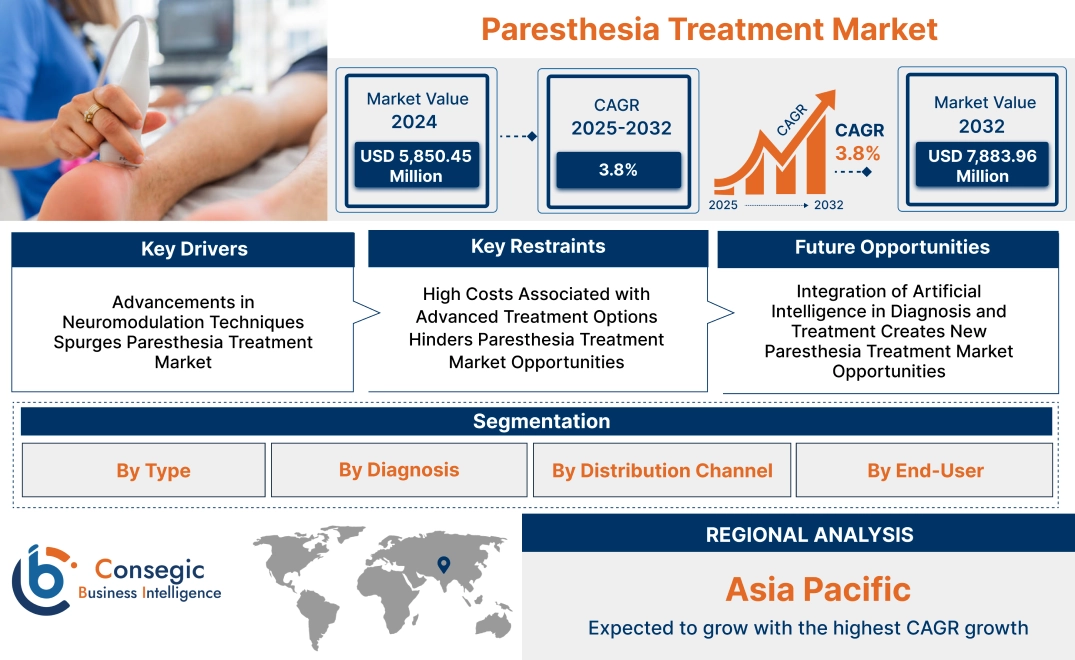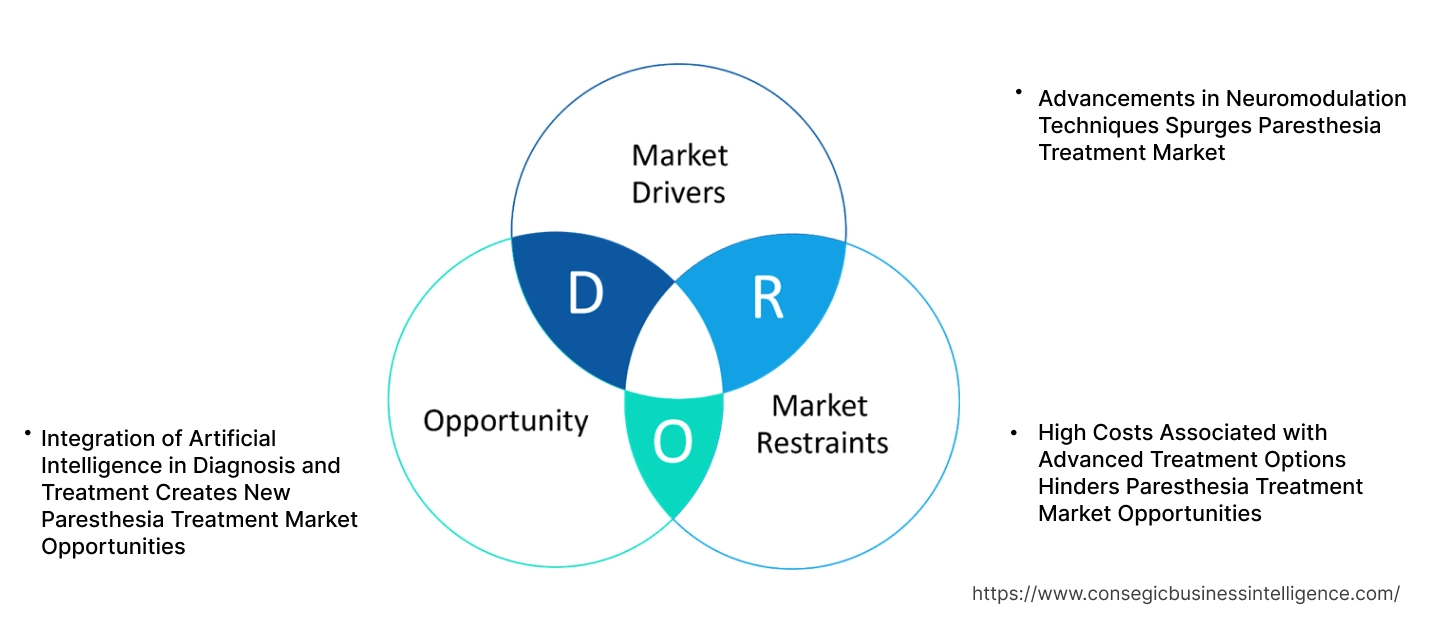Paresthesia Treatment Market Size:
Paresthesia Treatment Market size is estimated to reach over USD 7,883.96 Million by 2032 from a value of USD 5,850.45 Million in 2024 and is projected to grow by USD 5,968.52 Million in 2025, growing at a CAGR of 3.8% from 2025 to 2032.
Paresthesia Treatment Market Scope & Overview:
Paresthesia treatment focuses on addressing abnormal sensations, including tingling, numbness, or burning, caused by nerve dysfunction or damage. Additionally, the treatments offer precision targeting, symptom relief, and improved patient mobility, contributing to better overall health outcomes which in turn is fueling the paresthesia treatment market growth. Further, the treatments include medications, physical therapies, and surgical interventions designed to alleviate symptoms and restore nerve function which in turn is fueling the paresthesia treatment market demand.
How is AI Impacting the Paresthesia Treatment Market?
AI is revolutionizing the paresthesia treatment market by enhancing diagnostic accuracy, enabling personalized treatment approaches, and improving drug discovery and development, leading to better patient outcomes and a growing market for AI-driven healthcare solutions. AI algorithms improve the prediction of risks, such as nerve injury after tooth extraction, and help identify subtle abnormalities in medical images for earlier and more precise diagnosis. Additionally, AI facilitates the development of targeted therapies and digital health tools like telemedicine, expanding treatment access and improving patient adherence.
Paresthesia Treatment Market Dynamics - (DRO) :
Key Drivers:
Surging Prevalence of Chronic Diseases Fuels Market Growth
The rising prevalence of chronic diseases such as diabetes, cancer, and multiple sclerosis is boosting the paresthesia treatment market demand. Further, the increasing demand for effective treatments and management approaches for paresthesia is boosting the paresthesia treatment market growth. Furthermore, the ongoing research and development of treatment solutions for paresthesia is boosting the paresthesia treatment industry.
Therefore, the rising prevalence of chronic diseases is driving the need for treatment, in turn proliferating the growth of the market.
Key Restraints:
High Costs Associated with Advanced Treatment is Restraining the Market Growth
The implementation of advanced treatment options involves substantial costs, including the initial purchase, maintenance, and replacement of these systems which in turn is hindering the paresthesia treatment market expansion. Additionally, the requirement for specialized training for healthcare professionals adds additional financial strain to healthcare facilities in turn restraining the market progress.
Therefore, the high costs of treatment are hindering the paresthesia treatment market expansion.
Future Opportunities :
Integration of Artificial Intelligence in Diagnosis and Treatment is expected to Promote Potential Opportunities for Market Growth
The integration of AI in diagnosis and treatment helps to improve diagnosis, treatment planning, and personalized care for paresthesia which in turn is expected to create paresthesia treatment market opportunities. Further, AI-driven diagnostic tools help to analyze complex neurological data to provide accurate and early detection which in turn is boosting the market evolution.
Hence, the increasing adoption of AI in healthcare is anticipated to increase the utilization of treatment solutions in turn promoting prospects for paresthesia treatment market opportunities during the forecast period.
Paresthesia Treatment Market Segmental Analysis :
By Type:
Based on type, the paresthesia treatment market is segmented into chronic paresthesia and temporary paresthesia.
Trends in the Type:
- The trend towards increasing prevalence of chronic disorders is fueling the need for chronic paresthesia treatment.
Chronic Paresthesia accounted for the largest revenue share in the year 2024.
- Chronic paresthesia refers to prolonged and persistent tingling or numbness due to underlying conditions such as diabetes, multiple sclerosis, or nerve damage.
- Additionally, the increasing prevalence of diabetes and neurological disorders is fueling the market progress for chronic paresthesia.
- Further, healthcare providers are adopting innovative diagnostic and therapeutic approaches to improve patient outcomes for long-term conditions.
- Thus, as per the market analysis, the increasing prevalence of chronic diseases is driving the market evolution.
Temporary Paresthesia is anticipated to register the fastest CAGR during the forecast period.
- Temporary paresthesia is often caused by reversible factors like nerve compression, transient ischemic episodes, or physical inactivity.
- Additionally, temporary paresthesia is typically managed through non-invasive interventions such as physical therapy, ergonomic adjustments, or short-term pharmacological treatments.
- Further, the rising adoption of preventive care and wellness programs is fueling the market progress which in turn is fueling the cure for temporary paresthesia.
- Therefore, as per the market analysis, the rising adoption of preventive care and wellness programs is anticipated to boost the market during the forecast period.
By Diagnosis:
Based on diagnosis, the market is segmented into imaging tests (MRI, CT scan), electromyography (EMG), blood tests, and others.
Trends in the Diagnosis:
- The trend towards integration of AI-based tools with imaging systems is propelling the adoption of the imaging tests segment.
- The trend toward growing adoption of portable EMG devices is fueling the market progress.
Imaging Tests (MRI, CT scan) accounted for the largest revenue share in the year 2024.
- Imaging tests such as MRI and CT scans are crucial for identifying underlying neurological or vascular causes of paresthesia.
- Additionally, increased healthcare infrastructure investments for diagnostic facilities are boosting the market progress.
- Further, the proliferation of advanced imaging technologies to enhance diagnostic capabilities and accuracy is boosting the demand for imaging tests.
- Thus, as per the market analysis, the proliferation of advanced imaging technologies is driving the adoption of imaging tests.
Electromyography (EMG) is anticipated to register the fastest CAGR during the forecast period.
- Electromyography is used to measure electrical activity in muscles and nerves, providing critical insights into nerve dysfunction or muscle disorders.
- Additionally, healthcare providers rely on EMG for early diagnosis and monitoring treatment which in turn is the adoption of various treatment such as splinting, physical therapy, or surgery.
- Further, the rising need for cost-effective and efficient diagnostic procedures is accelerating the adoption of electromyography.
- Therefore, as per the market analysis, the rising need for cost-effective and efficient diagnostic procedures is anticipated to boost the market during the forecast period.
By Distribution Channel:
Based on distribution channel, the market is segmented into hospital pharmacies, retail pharmacies, and online pharmacies.
Trends in the Distribution Channel:
- The trend toward the ability to provide efficient medication management systems is driving the adoption of hospital pharmacies.
- The trend towards growing e-commerce healthcare services is fueling the adoption of online pharmacies.
The hospital pharmacies accounted for the largest revenue share of 46.50% in the year 2024.
- Hospital pharmacies play a vital role in dispensing medications prescribed during inpatient and outpatient care for paresthesia.
- Additionally, the availability of specialized drugs is propelling the adoption of hospital pharmacies.
- Further, the expanding healthcare infrastructure and investment in hospital facilities are driving the need for hospital pharmacies.
- Thus, according to the paresthesia treatment market analysis, expanding healthcare infrastructure is driving the need for hospital pharmacies.
The online pharmacies is anticipated to register the fastest CAGR during the forecast period.
- Online pharmacies provide convenience and accessibility, enabling patients to purchase medications from the comfort of their homes.
- Additionally, online pharmacies offer cost-effective solutions through discounts and home delivery options, enhancing patient satisfaction.
- Further, the growing adoption of digital healthcare platforms is boosting the market progress.
- Therefore, according to the paresthesia treatment market analysis, the growing adoption of digital healthcare platforms is anticipated to boost the market during the forecast period.
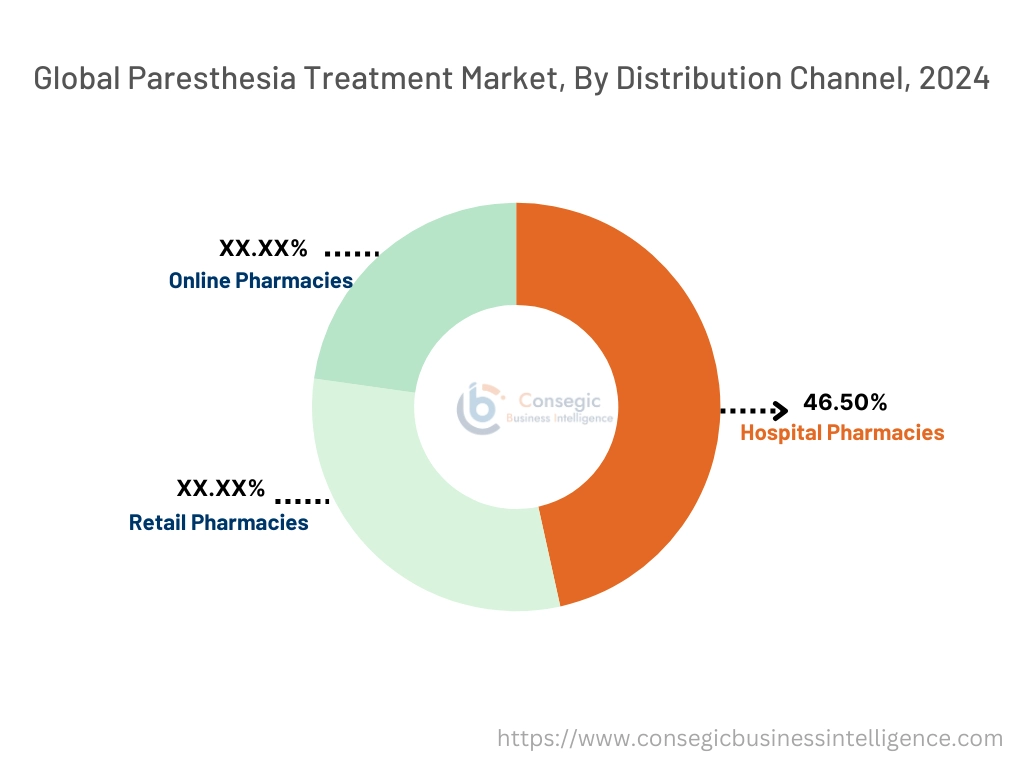
By End-User:
Based on end user, the market is segmented into hospitals, specialty clinics, ambulatory surgery centers, and home care settings.
Trends in the End User:
- The advancements in medical technology and an aging population are driving the adoption of hospitals which in turn is fueling the paresthesia treatment market trends.
- The increasing prevalence of chronic diseases and advancements in medical equipment is propelling the adoption of specialty clinics which in turn is boosting the paresthesia treatment market trends.
Hospitals accounted for the largest revenue share in the year 2024.
- Hospitals offer a comprehensive range of diagnostic and therapeutic services, making them primary centers for managing paresthesia.
- Additionally, the presence of advanced diagnostic technologies is driving the adoption of hospitals for treatment which in turn boosts the paresthesia treatment market size.
- Further, the increasing investment in expanding the infrastructure of government and private hospitals is driving the paresthesia treatment market share.
- Thus, as per the market analysis, increasing investment in expanding infrastructure is driving the market adoption in hospitals.
Specialty Clinics is anticipated to register the fastest CAGR during the forecast period.
- Specialty clinics focus on personalized care and targeted treatments for neurological and musculoskeletal disorders, including paresthesia.
- Additionally, the rising demand for cost-effective treatment options is propelling the adoption of specialty clinics which in turn is fueling the paresthesia treatment market share.
- Further, expanding healthcare networks and increased availability of specialists bolster this segment's growth prospects.
- Therefore, as per the market analysis, the rising demand for cost-effective treatment options is anticipated to boost the market during the forecast period.
Regional Analysis:
The regions covered are North America, Europe, Asia Pacific, the Middle East and Africa, and Latin America.
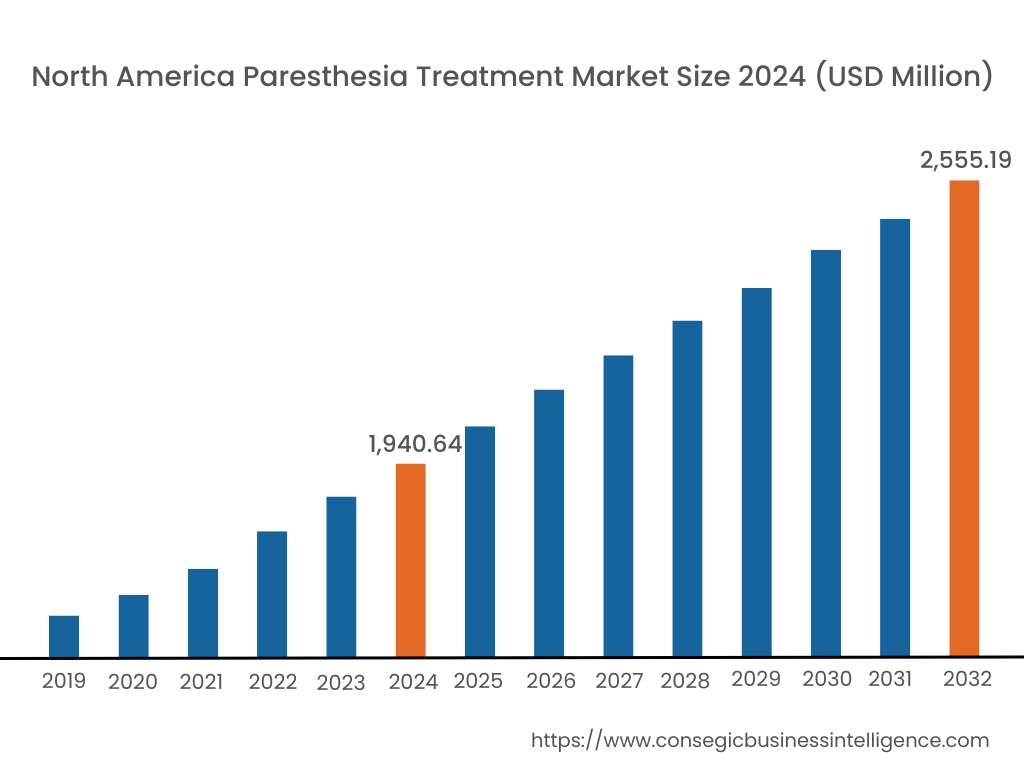
In 2024, North America was valued at USD 1,940.64 Million and is expected to reach USD 2,555.19 Million in 2032. In North America, the U.S. accounted for the highest share of 70.60% during the base year of 2024. The North American region's growing advanced healthcare infrastructure as well as high patient awareness of neurological disorders offer lucrative growth prospects for the market. Additionally, the increased focus on neurological research is driving the market progress.
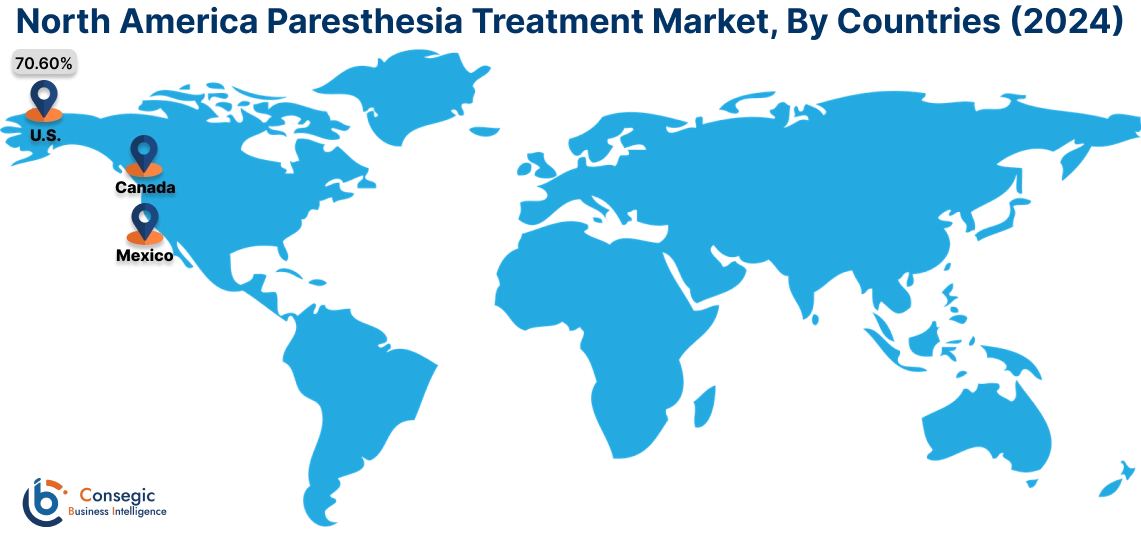
In Asia Pacific, the market is experiencing the fastest growth with a CAGR of 4.2% over the forecast period. The market is mainly driven by a well-established healthcare system and high awareness of neurological conditions. Furthermore, factors including growing healthcare investments and others are projected to drive the market growth in the Asia Pacific region during the forecast period.
- For instance, in March 2024, Wipro GE Healthcare announced an investment of over USD 800 million to address the growing domestic and international healthcare market.
The regional evaluation depicts that the strong healthcare system, increased focus on neurological disorders, and government funding for research and treatment are driving the market in Europe. Additionally, the key factor driving the market is the growing healthcare infrastructure is driving demand for advanced treatments and is propelling the market progress in the Middle East and African region. Further, the rising awareness of neurological conditions as well as increasing focus on healthcare improvements is paving the way for the progress of the market in the Latin America region.
Top Key Players and Market Share Insights:
The global paresthesia treatment market is highly competitive with major players providing paresthesia treatment to the national and international markets. Key players are adopting several strategies in research and development (R&D), product innovation, and end user launches to hold a strong position in the paresthesia treatment industry. Key players in the paresthesia treatment market include-
- Pfizer Inc. (United States)
- Eli Lilly and Co. (United States)
- Mylan N.V. (United States)
- GlaxoSmithKline plc (United Kingdom)
- Johnson & Johnson (United States)
- Bristol-Myers Squibb (United States)
- Sanofi S.A. (France)
- AstraZeneca PLC (United Kingdom)
- Teva Pharmaceutical Industries Ltd. (Israel)
- Novartis International AG (Switzerland)
Paresthesia Treatment Market Report Insights :
| Report Attributes | Report Details |
| Study Timeline | 2019-2032 |
| Market Size in 2032 | USD 7,883.96 Million |
| CAGR (2025-2032) | 3.8% |
| By Type |
|
| By Diagnosis |
|
| By Distribution Channel |
|
| By End-User |
|
| By Region |
|
| Key Players |
|
| North America | U.S. Canada Mexico |
| Europe | U.K. Germany France Spain Italy Russia Benelux Rest of Europe |
| APAC | China South Korea Japan India Australia ASEAN Rest of Asia-Pacific |
| Middle East and Africa | GCC Turkey South Africa Rest of MEA |
| LATAM | Brazil Argentina Chile Rest of LATAM |
| Report Coverage |
|
Key Questions Answered in the Report
How big is the paresthesia treatment market? +
The paresthesia treatment market size is estimated to reach over USD 7,883.96 million by 2032 from a value of USD 5,850.45 million in 2024 and is projected to grow by USD 5,968.52 million in 2025, growing at a CAGR of 3.8% from 2025 to 2032.
Which segmentation details are covered in the paresthesia treatment report? +
The paresthesia treatment report includes specific segmentation details for type, diagnosis, distribution channel, end user, and regions.
Which is the fastest segment anticipated to impact the market growth? +
In the paresthesia treatment market, online pharmacies are the fastest-growing segment during the forecast period due to the growing adoption of digital healthcare platforms.
Who are the major players in the paresthesia treatment market? +
Pfizer Inc. (United States), Eli Lilly and Co. (United States), Bristol-Myers Squibb (United States), Sanofi S.A. (France), AstraZeneca PLC (United Kingdom), Teva Pharmaceutical Industries Ltd. (Israel), Novartis International AG (Switzerland), Mylan N.V. (United States), GlaxoSmithKline plc (United Kingdom), Johnson & Johnson (United States) are the major players in the Paresthesia Treatment market.
What are the key trends in the paresthesia treatment market? +
The paresthesia treatment market is being shaped by several key trends including advancements in medical technology and the aging population as well as the increasing prevalence of chronic diseases and advancements in medical equipment and other key trends are driving the market.
